- Home
- H. Rider Haggard
King Solomon's Mines (Barnes & Noble Classics Series) Page 2
King Solomon's Mines (Barnes & Noble Classics Series) Read online
Page 2
Prefiguring Edgar Rice Burrough’s Tarzan books and other popular literature, King Solomon’s Mines is genuinely involved with Africa, however consciously Haggard mythicizes the subject matter. This is only to be expected in an author for whom Africa was a subject of lasting preoccupation. Born in West Bradenham Hall, Norfolk, England, in 1856, the son of a country squire, Henry Rider Haggard was seen as unpromising by his family. When young Henry failed to get an army commission, he was sent off to Natal, South Africa, in 1875 as secretary to the governor of Britain’s Natal colony. His career advanced, and in 1877 he transferred jobs, to work for the special commissioner. The following year he became master and registrar of the High Court in the Transvaal. His six years in Africa would provide inspiration for the rest of his writing life.
His friend Andrew Lang would later write that Haggard had “found himself” by writing King Solomon’s Mines. One might add that Haggard found himself even before, by going to Africa, which transformed a rather muddled civil servant into a decisive and productive Victorian writer. This metamorphosis is akin to the change experienced by another Victorian novelist, Anthony Trollope (1815-1882), after Trollope landed a job as post-office inspector in Ireland, which awakened his own latent talents.
Haggard was deeply involved with public service, and published many books of history and advocacy, most of which are unread today. He never took his adventure stories as seriously as his nonfiction books, such as Cetywayo and His White Neighbours; Or, Remarks on Recent Events in Zululand, Natal, and the Transvaal (London: Trübner and Company, 1882); The Last Boer War (London: Kegan Paul and Company, 1899); and A History of the Transvaal, (New York: New Amsterdam Book Company, 1900). Obsessed with the fate of poor rural communities, he published studies like A Farmer’s Year: Being His Commonplace Book for 1898 (London: Longmans and Company, 1899; The Poor and the Land: Being a Report on the Salvation Army Colonies in the United States and at Hadleigh, England, with Scheme of National Land Settlement, and an Introduction (London, New York: Longmans, Green, 1905); Rural Denmark and Its Lessons (London, New York: Longmans, Green, 1911); Regeneration: Being an Account of the Social Work of the Salvation Army in Great Britain (London: Longmans, Green, 1910); and Rural England: Being an Account of Agricultural and Social Researches Carried Out in the Years 1901 & 1902 (London, New York: Longmans, Green, 1902). Haggard also wrote extensively about World War I: A Call to Arms to the Men of East Anglia (London: R. Clay,1914), and The After-War Settlement and Employment of Ex-Servicemen in the Oversea Dominions (London: Published for the Royal Colonial Institute by the Saint Catherine Press, 1916).
Although few fans of Haggard’s novels today have read these hard-to-find nonfiction texts, Haggard himself felt they represented his highest achievements. Unlike Sir Arthur Conan Doyle, who valued his own eccentric writings on spiritualism over his immortal Sherlock Holmes stories, Haggard may have been at least partly right in his evaluation of his own work. The myths so abundant in King Solomon’s Mines and She are bolstered by factual material, hard-won life experience of the kind detailed in Haggard’s books about history, agriculture, and war, as well as in his private diaries and letters. The latter are better known since Denys Edwin Whatmore self-published a series of short books containing excerpts from Haggard’s letters about activities for the public good. Three of these titles are: Deeds for the Church: Rider Haggard (Cheltenham: D. E. Whatmore, 1995); Deeds for Children and Young People: Rider Haggard (Cheltenham: D. E. Whatmore, 1996); and Deeds for the Salvation Army: Rider Haggard (Cheltenham: D. E. Whatmore, 1996). In addition, the Rider Haggard Society (www.riderhaggardsociety.org.uk), a British organization, has through its occasional journal worked since 1985 to propagate a more rounded view of Haggard. Even so, the only two texts by Haggard that are still widely read remain and look likely to remain—She and King Solomon’s Mines.
Rapid Writing
Haggard admitted he wrote King Solomon’s Mines in six weeks, a quickness that surprised his writer friends like Andrew Lang and Robert Louis Stevenson. The latter sent Haggard a letter cautioning him about excessive haste. Yet the famed Belgian-born detective storywriter Georges Simenon (1903-1989) often wrote entire books even faster. The French novelist Stendhal (Marie Henri Beyle, 1783-1842) typically completed novels in a matter of weeks. Speed in writing per se is not necessarily a threat to quality; adventure writers in particular can be like the journalists of whom the noted critic Karl Kraus (1874-1936) wrote, “They write worse when they have time.” Pacing was essential for Haggard, who claimed that writing a text fast helped to energize it, making it irresistibly readable. He described his approach with typical dash in his autobiography, The Days of My Life (1926; see “For Further Reading”): “Such work should be written rapidly and, if possible, not rewritten, since wine of this character loses its bouquet when it is poured from glass to glass.”
The speed of writing translates to speed of reading, with as few impediments as possible to the reader’s momentum. Although there are a number of exotic words in King Solomon’s Mines that require annotation, their frequency decreases as the book advances, and Haggard often provides his own, perfectly serviceable translation of local terms. As a result, the reader does not need to pause to understand the reference, but can plunge ahead to find out what happens next, which is essential for the enjoyment of a real page-turner like King Solomon’s Mines.
Despite Haggard’s speed and occasional carelessness about details, King Solomon’s Mines shows some real control of structural and stylistic elements, which is part of its lasting power. To cite one stylistic aspect used coherently throughout the book, Haggard used italics almost always to convey the horror of death, such as when an elephant picked up a servant “and tore him in two” (p. 46). In a cave discovered along his trip, Quatermain finds that a servant who was alive the night before is now “stone dead” (p. 68). These italics denoting urgent shock in relation to death recur throughout the story, like underlining in a letter excitedly dashed off to a friend.
One of Haggard’s goals, as expressed in “About Fiction” (Contemporary Review, February 1887), was to create an interesting book, as he felt the Anglo-American novel had declined into a series of dull domestic dramas. Haggard alluded to William Dean Howells (1837-1920), who wrote novels like A Woman’s Reason (1883), A Modern Instance (1882), and The Rise of Silas Lapham (1885), as an example. By focusing on the imaginative and fantastic domains, Haggard aimed at exciting the reader in the way that he felt naturalistic nineteenth-century fiction had ceased to do. In this goal he succeeded brilliantly, as generations of readers have conceded.
In King Solomon’s Mines, with a dour feeling of fatalism, the elephant hunter Allan Quatermain agrees to join a dangerous treasure hunt. Quatermain is presented as an amateur author, whose first statement at the beginning of the book is one of modesty, of being aware of his book’s “shortcomings.” As narrator, Quatermain dithers over lore and legends that he might have included in King Solomon’s Mines had he “given way to [his] own impulses” (p. 7). Authorship as a form of discipline and control is also expressed at the end of the story, when Quatermain announces, “And here, at this point, I think I shall end this history” (p. 207). The reader is reminded that the story does not end by itself; the writer ends it. Control and consciousness were keywords for Quatermain as an author—and quite possibly for Haggard as well.
Haggard’s protagonist Quatermain describes himself as a 55-year-old man who has survived the job of elephant hunter much longer than most of his colleagues. Quatermain explains at the start of his tale, “I am a timid man, and don’t like violence,” (p. 9) and near the end, after many heroics, he reiterates, “I never had any great pretensions to be brave” (p. 188). Such self-definitions are repeated throughout the book until the narrative itself begins to seem like a means of self-definition. The effort to write, as well as the events narrated, define the narrator.
There may not be much progression of character in King Solomon’s Mines, but Quate
rmain rings true precisely because of his lack of grandiose pretensions. Quatermain’s self-deflating tone may include something of Haggard’s own ironic self-regard. When Haggard traveled to Africa in 1914 and his photo was plastered on the local newspaper Natal Witness, Haggard noted in his diary that his image looked “exactly like that of the mummy of Rameses the Second,” a recently disinterred Pharaoh. This lack of vanity or vaingloriousness is unusual in a generation of writers on Africa that included such egomaniacs as Sir Richard Burton, translator of The Arabian Nights.
At the start of chapter 1, Quatermain informs us: “I am not a literary man, though very devoted to the Old Testament and also to the ‘Ingoldsby Legends’” (p. 9); the latter is an early Victorian compilation of odd and grotesque jokes in prose and verse by Richard Harris Barham (1788-1845). Mention of The Ingoldsby Legends is a running gag throughout the King Solomon’s Mines. Quatermain misattributes lines from Walter Scott to “Ingoldsby” in a jape that resulted in a chiding letter from Robert Louis Stevenson, who thought the error was Haggard’s own, rather than his protagonist Quatermain’s. Reflecting its narrator’s literary tastes, King Solomon’s Mines veers in tone between the Victorian jokes of The Ingoldsby Legends and the sober majesty of the Old Testament. As the story advances, the Bible and The Ingoldsby Legends are repeatedly invoked until they are yoked together in an unlikely identification. During one potentially tragic moment in chapter 6 when Quatermain and his friends are dying of thirst, the narrator decides to read the poem “The Jackdaw of Rheims” from The Ingoldsby Legends (p. 59). Later, at the height of battle, Quatermain states: “Warlike fragments from the ‘Ingoldsby Legends,’ together with numbers of sanguinary verses from the Old Testament, sprang up in my brain like mushrooms in the dark” (p. 148). The disparate texts join as inspiration for the bloodbath to come.
The influence of the Bible on King Solomon’s Mines can hardly be overstated, starting with the title itself, which honors a biblical monarch renowned both for his wisdom and his wealth. Aside from many explicit references, there are also many biblical allusions, such as when Sir Henry Curtis convinces Quatermain to join the expedition to Africa. Curtis explains that the company will search for his lost brother Neville: “We had quarrelled bitterly, and I behaved very unjustly to my brother in my anger” (p.16). This description echoes the prose cadences of the King James Bible; the fratricidal story of Cain and Abel from the Bible is surely not far behind. This richness of reference is part of the lasting fascination of King Solomon’s Mines.
When the travelers arrive at the Hall of the Dead to discover the beheaded, mummified corpse of a Zulu king, Quatermain likens this horrific image to Hamilton Tighe, a beheaded sailor who in The Ingoldsby Legends appears carrying his own head (p. 176).
Racism and Sexism
The depiction of Africans in King Solomon’s Mines has rightly attracted much condemnation in recent years. At the start of the book, Quatermain announces that he doesn’t like calling natives by the term that today has become known as “the n-word” and yet he abundantly uses another term, kafir, which in South Africa is hardly less offensive (p. 11). The villainous king Twala is introduced as having “the most entirely repulsive countenance we had ever beheld. The lips were as thick as a negro’s, the nose was flat, it had but one gleaming black eye ... and its whole expression was cruel and sensual to a degree” (p. 96).
It is true that Quatermain says some Africans are gentlemen, while some “mean whites with lots of money” are not (p. 10). Still, the book contains some mean-spirited jokes against Africans, such as when some natives sample champagne belonging to their employers and Quatermain tells them that it is medicine and they are “as good as dead men. They went on to the shore in a very great fright, and I do not think that they will touch champagne again” (p. 27). Presumably this joke was intended as punishment for stealing champagne, but it seems unjustified all the same.
Africans are also the subject of some bluff, gross-out humor, such as the gratuitous account of a native whose toe amputation “was a pleasure to see,” followed by the “Kafir” asking after the operation for a white toe to be attached in place of the missing one (p. 33). Perhaps the most low-minded instance of racism in the book occurs when Umbopa, eventually revealed as exiled royalty whose real name is Ignosi, states that “black people” do not “hold life so high as [whites]” (p. 118). By having an African say this, Haggard lends extra authority to this dehumanizing notion. Similarly, the native maiden Foulata declares herself opposed to miscegenation: “‘Can the sun mate with the darkness, or the white with the black?’” (p. 197). Putting racist sentiments in the mouths of African characters is a particularly insidious form of racist discourse.
Yet the nobility of Umbopa/Ignosi as depicted in King Solomon’s Mines is undeniable. Haggard does not have a uniformly low opinion of Africans, at least not much lower than his view of humanity in general. Elephants stampeding during a hunt are described as pushing one another “in their selfish panic, just like so many human beings” (p. 44). Haggard is suggesting that animals at their worst can be as bestial as humans. Africans who are spared the impediments of modern Western culture might be noble, but they can sometimes reveal character flaws as bad as Western man’s.
Similarly, Quatermain’s translations of what certain Africans say in the narrative reflect his view of Africa and Africans. Umpoba speaks of the mountains leading to the treasure as “a strange land there, a land of witchcraft and beautiful things; a land of brave people, and of trees, and streams, and white mountains, and of a great white road” (p. 50). The noble Umbopa’s prose cadences seem to prefigure the style of Ernest Hemingway. Yet elsewhere the ancient, evil African crone Gagaoola intones: “Blood! blood! blood! rivers of blood; blood everywhere ... Footsteps! footsteps! footsteps! the tread of the white man coming from afar” (p. 100). The thrice-repeated rhythmic incantations are comparable to the Civil War tune, “Tramp! Tramp! Tramp! The boys are marching,” by George Frederick Root (1820-1895), as well as ballads by Haggard’s friend Rudyard Kipling, like “Gunga Din”: “It was ‘Din! Din! Din! / ’Ere’s a beggar with a bullet through ‘is spleen.’”
Haggard applies European history—and not just English prosody—to Africa by having Captain Good, a friend of Sir Henry Curtis, refer to the murderous King Twala as “just like a black Madame Defarge” (p. 110). The French Revolutionary character Madame Defarge in Charles Dickens’ A Tale of Two Cities (1859) is ferociously vengeful and knits the names of her intended victims. Yet in King Solomon’s Mines Quatermain and his party, not Africa and King Twala, are, in their plot to overthrow a cruel king, the real revolutionary participants. This curiously layered simile is typical of the complexity and contradictions of King Solomon’s Mines.
Women too are treated roughly in King Solomon’s Mines. Quatermain informs the reader almost casually that “women bring trouble as surely as the night follows the day” (p. 119). Shortly after this misogynistic statement, murder is described as a kind of symbolic rape, when the young maiden Foulata is threatened with ritual execution by a leering aggressor who taps his spear and cries, “She shrinks from the sight of my little plaything even before she has tasted it” (p. 121).
King Solomon’s Mines reflects an awareness of what may be called the Eros of otherness. In a running gag repeated ad nauseum, Captain Good’s bare white legs are the objects of admiration for Africans who “satisfy their aesthetic longings” (p. 127) by staring at them, as Quatermain puts it with heavy ironic humor. Descriptions of Kukuana women fall into racial stereotypes: “the lips are not unpleasantly thick as is the case in most African races” (p. 88). Umbopa is described as a “tall, handsome-looking man, somewhere about thirty years of age, and very light-coloured for a Zulu” (p. 35). Haggard accepts the racist notion that lighter skin is handsomer than dark, and Africans are most beautiful when they look less African and more European in appearance.
Even beautiful Africans are not described in any great admiring detail. Umbopa g
ets only a passing reference about a period of famine during which he wore “a leather belt strapped so tight round his stomach ... that his waist looked like a girl‘s” (p. 67). This mild observation scarcely has the erotic charge of the words describing a dead athlete who wears a “garland briefer than a girl’s” in A. E. Housman’s “To An Athlete Dying Young,” in his classic 1896 collection A Shropshire Lad. Some critics have written about homoerotic aspects of King Solomon’s Mines, but in truth they are difficult to find.
Still, the descriptions of sexuality in King Solomon’s Mines have attracted much critical comment. One critic even noted that H. Rider Haggard and Sigmund Freud were born in the same year, 1856. Thus, when Haggard is described by other critics as “pre-Freudian,” this is not strictly true. Extra-Freudian or Super-Freudian might be a more apt term, as Haggard’s directness in sexual matters almost makes Freudian interpretation seem obsolete.
Instead of being buried in the unconscious, sexuality is right on the surface in Haggard’s world, as in the map leading to King Solomon’s Mines, which names mountains known as Sheba’s Breasts that are on the way to the treasure (p. 22). An accompanying text supposedly written in 1590 by the Portuguese adventurer José da Silvestra when he was “dying of hunger,” also refers to “the north side of the nipple of the southernmost of the two mountains I have named Sheba’s Breasts” (p. 23). Da Silvestra adds that any future treasure seeker must “climb the snow of Sheba’s left breast till he comes to the nipple” (p. 23). In Victorian England, where in sitting rooms, piano legs were prudishly covered by rugs and referred to coyly as “limbs,” this frank description of female body parts must have been powerful. The impact must have been something close to the impact on later generations of nude photographs of African women in National Geographic magazines. Elizabeth Bishop’s poem “In the Waiting Room” describes a young girl sitting in a dentist’s office circa 1918, waiting for her Aunt, who is being treated. She looks at the photographs in a National Geographic magazine: “black, naked women with necks / wound round and round with wire / like the necks of light bulbs. / Their breasts were horrifying.” Likewise, Haggard’s young readers, boys and girls both, were confronted by unexpected references to the unadorned female body in King Solomon’s Mines.

 The Ivory Child
The Ivory Child She and Allan
She and Allan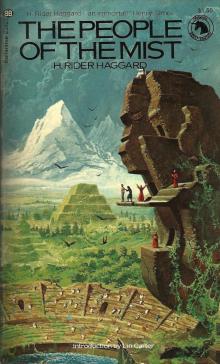 The People of the Mist
The People of the Mist She
She Morning Star
Morning Star King Solomon's Mines
King Solomon's Mines She: A History of Adventure
She: A History of Adventure Cleopatra
Cleopatra Ayesha, the Return of She
Ayesha, the Return of She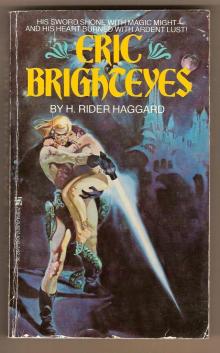 Eric Brighteyes
Eric Brighteyes Red Eve
Red Eve Fair Margaret
Fair Margaret When the World Shook
When the World Shook Lysbeth, a Tale of the Dutch
Lysbeth, a Tale of the Dutch Moon of Israel: A Tale of the Exodus
Moon of Israel: A Tale of the Exodus Long Odds
Long Odds The Ghost Kings
The Ghost Kings Pearl-Maiden: A Tale of the Fall of Jerusalem
Pearl-Maiden: A Tale of the Fall of Jerusalem Allan and the Holy Flower
Allan and the Holy Flower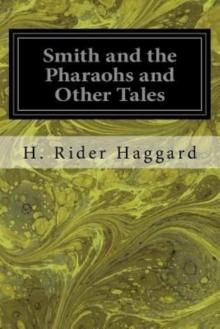 Smith and the Pharaohs, and other Tales
Smith and the Pharaohs, and other Tales The Wanderer's Necklace
The Wanderer's Necklace Dawn
Dawn The Lady of Blossholme
The Lady of Blossholme Stella Fregelius: A Tale of Three Destinies
Stella Fregelius: A Tale of Three Destinies Allan Quatermain
Allan Quatermain Montezuma's Daughter
Montezuma's Daughter Jess
Jess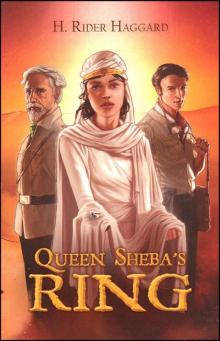 The Brethren
The Brethren Allan's Wife
Allan's Wife Child of Storm
Child of Storm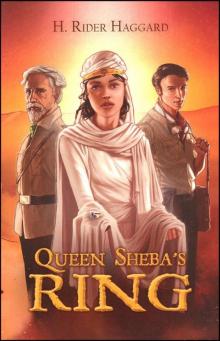 Queen Sheba's Ring
Queen Sheba's Ring King Solomon's Mines (Barnes & Noble Classics Series)
King Solomon's Mines (Barnes & Noble Classics Series) Complete Allan Quatermain Omnibus - Volumes 1 - 10
Complete Allan Quatermain Omnibus - Volumes 1 - 10